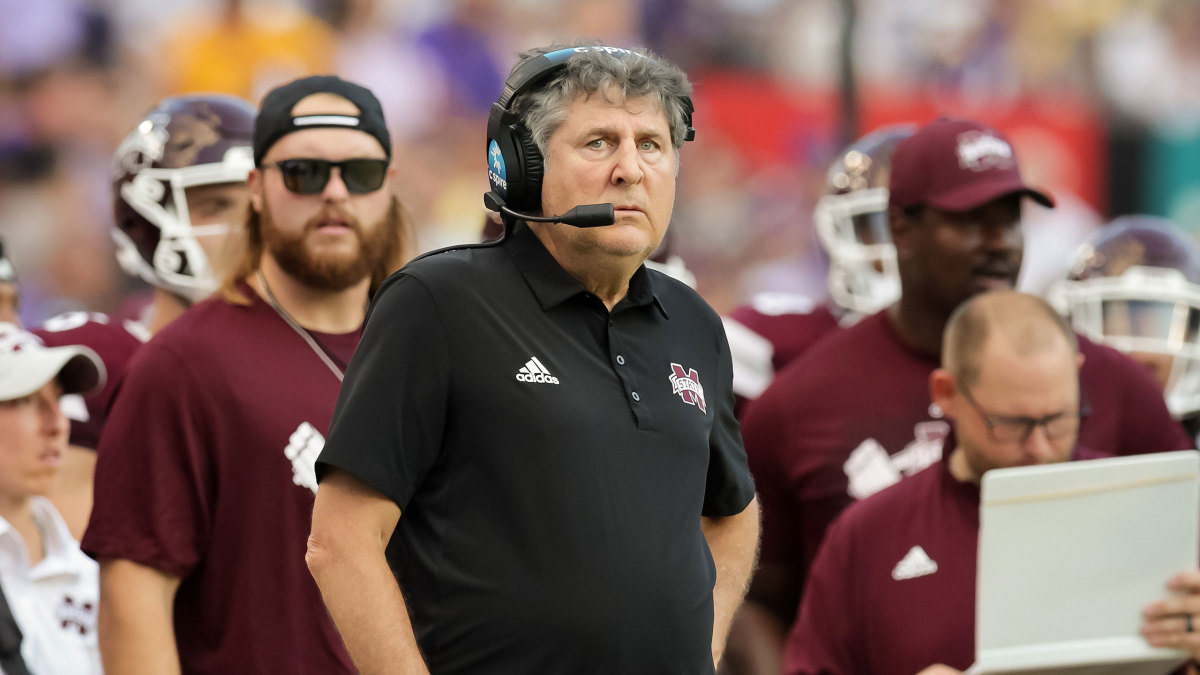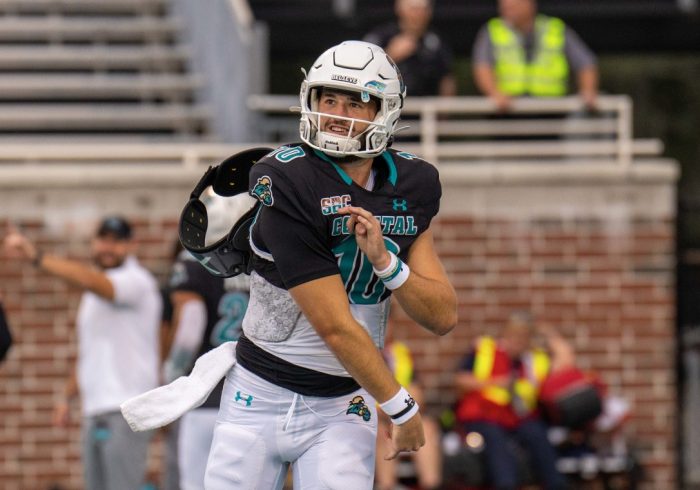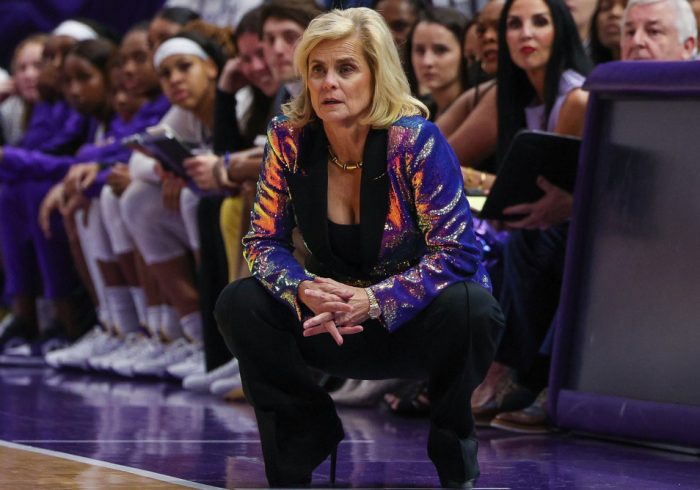Fifteen months into the era of name, image and likeness (NIL), Mike Leach has come to a realization like so many within the industry: College sports have been professionalized. And it is time, he says, for college athletes to become professionals. It’s time for a player draft. It’s time for salary caps, for trades and for player cuts.
Caught in a purgatory between amateurism and professionalism since NIL was legalized in July 2021, college sports should take the full leap into the latter, the Mississippi State football coach says.
“This should not be a masquerade party of professionals. Are you a professional or are you not?” says Leach during an interview in his office earlier this week. “Instead of sitting here and having 17-year-olds lecture everybody that they are professionals, well, let them be professionals. It’s one [amateur] or the other [professional]. Right now, we’ve got this whole mysterious stratosphere of people wiggling all over back and forth.”
Leach, 61, is no ordinary football coach. Far from the norm in his profession, he’s got a law degree from Pepperdine. He holds strong opinions, is a political junkie and enjoys a hearty debate, whenever he’s not breaking down film or biking around Key West.
Leach says college athletes should get the option of being amateur or professional, with all of the things those classifications entail.
Stephen Lew/USA TODAY Sports
Football seems trivial to him, almost like a hobby at which he excels greatly. He’d rather opine on current affairs and transformational issues. And in the world of college sports, there is no bigger national debate than the one raging over athlete compensation.
Naturally, he’s got some ideas on how to fix what stakeholders say is a festering problem that is impacting their game. Leach believes players should have a choice when entering college: You either join as an (1) amateur or you join as a (2) professional.
“With professionals comes responsibility,” he says. “Yeah, you will potentially make more money. But you are drafted and can be traded. That’s what professionals do. This college football group [of administrators], they are all shocked by that. Why are you shocked by it? Name one league of professionals who don’t do it that way.”
Like Leach, many high-profile football coaches are beginning to speak out about the current state of athlete compensation in college athletics, many of them frustrated at what has evolved into “legalized cheating,” as Ole Miss coach Lane Kiffin described it in May.
On Saturday, Alabama hosts Texas A&M four months after the two programs’ coaches were involved in a public spat over this exact topic. Nick Saban accused Texas A&M and Jimbo Fisher of using NIL to “buy every player on their team,” triggering an impromptu news conference in which Fisher suggested reporters dig into Saban’s own recruiting transgressions.
It’s no secret: Donor-led collectives and individual boosters are using NIL deals as a way to lure high school players and college transfers to their programs, paying out millions in the industry’s newest arms race. The top collectives in the country last year doled out upward of $4 million each to their school’s athletic programs, with top-flight football players earning six-figure salaries disguised as NIL payments.
School officials that at first resisted the collective movement are hurriedly entering the fray, mounting a late effort to rally their boosters out of fear they’ll be left behind. Other programs, having for months struggled through a disorganized multicollective approach, are consolidating their efforts, such as the one last week in Oxford.
The end goal: field the best team that your money can buy. But is there a better way? Boosters are funneling cash, with no cap restrictions, through third parties to distribute among a team of athletes who, unlike professional players, are not bound by contracts.
“Blow it all up, man,” Clemson coach Dabo Swinney told Sports Illustrated in April. “It needs to be blown up. It’s not sustainable where we are right now.”
Leach’s plan to categorize two kinds of college athletes—amateurs and professionals—is a similar concept used in professional golf tournaments, where amateurs can compete while unable to win cash prizes.
Under Leach’s plan, amateurs follow similar rules currently applied to college athletes. They are unpaid and they can freely transfer. However, amateurs would receive a $100,000 bonus once they graduate from the school with which they originally signed. If you transfer, Leach says, you’d give up the right to earn the bonus.
Those choosing to be professionals would be paid a salary from the school, sign a binding contract, and could be traded and cut from the team. They still must attend school. School salary pools are structured similar to the NFL, where franchises are limited in their spending.
“It’s not [where] the biggest and richest school pays the most money for them,” says Leach. “That destroys the game. The NFL has a salary cap.”
In Leach’s plan, professionals cannot choose where they attend college because they are part of a draft that could include all 130 FBS programs—or, maybe, a subsection of programs that generate enough resources to pay athletes.
In a separate interview earlier this year about college football’s powers separating themselves, Swinney said, “Ultimately, there are going to be 40 to 50 teams, a commissioner and here are the rules. That can’t happen soon enough for me. You can’t have basketball or soccer or whatever the same as football. It’s just not the same. You have this, ‘Let’s make everything the same!’ We are so past that, 10 years past that.”
In this murky climate of college sports, high-level administrators have spent months exploring solutions to the issue of athlete compensation. The NCAA Transformation Committee has intensely discussed the topic, holding meetings that include some of the country’s leading labor attorneys. With every proposal, there are roadblocks and hurdles that prevent it from happening, they say. Any direct pay or revenue-sharing model would trigger athletes’ becoming employees, something many college sports leaders are against. Title IX is a hangup, too. Payments would need to be evenly spread across sports—male and female.
Without solutions, college officials have pleaded with Congress for assistance, something Leach says is wishful thinking. The latest is a potential bill from former college coach Tommy Tuberville, a Republican senator from Alabama. No real action is expected on Capitol Hill until next year, after the completion of the midterm elections.
“They can’t even solve their own problems,” Leach says of Congress. “They don’t know the first thing about football, and we’re going to defer to a bunch of people who don’t know what they’re doing? What is the time frame? I don’t think they get it accomplished, but in the event they do, we’ll all be dead.”
Leach’s plan has its share of holes, says Mit Winter, a sports attorney based in Kansas City who has handled NCAA-related cases. Professionalized college players would be employees of their university or their conference. In such a hybrid model, one half of a team (amateurs) would operate under NCAA rules that limit compensation—a potential antitrust problem—while the other half (professional) is governed by state employment laws as well as a collectively bargained agreement.
“Practically, it would be very hard to manage a team,” Winter says. “Coaches talk about how chaotic managing a roster is now. Well, this seems even more chaotic to me.”
The athlete employment debate has gained momentum over the last several years as revenue growth within the college sports industry continues to expand in varying ways, mostly because of men’s basketball and football. For instance, in the most recent revenue windfalls, the Big Ten struck a TV deal to earn $1.1 billion annually, and leaders just approved an expansion to the College Football Playoff that could fetch $2 billion a year.
Even many within college sports believe that employment status is coming for athletes at some point. At least four routes exist that could eventually deem athletes employees, starting with complaints filed with both the Equal Employment Opportunity Commission and the National Labor Relations Board.
In Pennsylvania, a court case, Johnson v. NCAA, is working its way through the system and would make athletes employees. The fourth route to athlete employment status is Congress. Several bills could lay a legal path for schools to provide athletes collective bargaining rights and even revenue-sharing provisions. This topic is nothing new, though coaches are speaking out more than ever.
Andy Schwarz, an economist in California specializing in sports, believes college sports leaders should go with it. “Just admit this is a market for talent and stop pretending it’s not, then regularize it, not with collusive ‘guardrails’ but with contracts and negotiated frameworks,” he told SI this summer.
Is college football headed for a professionalized model? Leach isn’t the only one who believes it’s the only way out.
“The landscape is shaky right now,” says Cincinnati coach Luke Fickell. “We’re at a crossroads to what direction we’re going to go. You can’t keep dabbling down this road. You have to truly take the left turn and put a structure behind it and keep a little bit of what we’ve known as college athletics. Or football and basketball go the other route for semipro.”
More College Football Coverage:
• Six Trap Games in Week 6
• Wisconsin Makes Season’s Most Ruthless Firing Yet
• Big 12 Leads College Football’s New World Order



